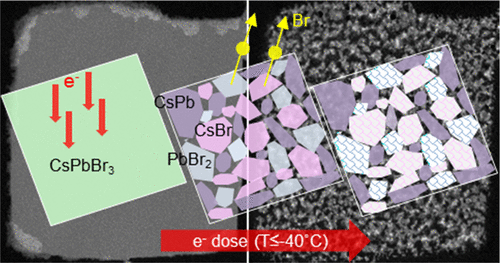Our official English website, www.x-mol.net, welcomes your
feedback! (Note: you will need to create a separate account there.)
Low-Temperature Electron Beam-Induced Transformations of Cesium Lead Halide Perovskite Nanocrystals
ACS Omega ( IF 3.7 ) Pub Date : 2017-09-08 00:00:00 , DOI: 10.1021/acsomega.7b01009 Zhiya Dang , Javad Shamsi 1 , Quinten A. Akkerman 1 , Muhammad Imran 1 , Giovanni Bertoni 2 , Rosaria Brescia , Liberato Manna
ACS Omega ( IF 3.7 ) Pub Date : 2017-09-08 00:00:00 , DOI: 10.1021/acsomega.7b01009 Zhiya Dang , Javad Shamsi 1 , Quinten A. Akkerman 1 , Muhammad Imran 1 , Giovanni Bertoni 2 , Rosaria Brescia , Liberato Manna
Affiliation

|
Cesium lead halide perovskite (CsPbX3, with X = Br, Cl, I) nanocrystals have been found to undergo severe modifications under the high-energy electron beam irradiation of a transmission electron microscope (80/200 keV). In particular, in our previous work, together with halogen desorption, Pb2+ ions were found to be reduced to Pb0 and then diffused to form lead nanoparticles at temperatures above −40 °C. Here, we present a detailed irradiation study of CsPbBr3 nanocrystals at temperatures below −40 °C, a range in which the diffusion of Pb0 atoms/clusters is drastically suppressed. Under these conditions, the irradiation instead induces the nucleation of randomly oriented CsBr, CsPb, and PbBr2 crystalline domains. In addition to the Br desorption, which accompanies Pb2+ reduction at all the temperatures, Br is also desorbed from the CsBr and PbBr2 domains at low temperatures, leading to a more pronounced Br loss, thus the final products are mainly composed of Cs and Pb. The overall transformation involves the creation of voids, which coalesce upon further exposure, as demonstrated in both nanosheets and nanocuboids. Our results show that although low temperatures hinder the formation of Pb nanoparticles in CsPbBr3 nanocrystals when irradiated, the nanocrystals are nevertheless unstable. Consequently, we suggest that an optimum combination of temperature range, electron energy, and dose rate needs to be carefully chosen for the characterization of halide perovskite nanocrystals to minimize both the Pb nanoparticle formation and the structural decomposition.
中文翻译:

铯铅卤化物钙钛矿纳米晶体的低温电子束诱导转变
卤化铯铅钙钛矿(CsPbX 3,X = Br,Cl,I)已发现在透射电子显微镜(80/200 keV)的高能电子束辐照下经历了严重的修饰。特别是,在我们先前的工作中,与卤素解吸一起,发现Pb 2+离子被还原为Pb 0,然后在高于-40°C的温度下扩散形成铅纳米颗粒。在这里,我们介绍了在低于-40°C的温度下CsPbBr 3纳米晶体的详细辐照研究,该温度范围内Pb 0原子/团簇的扩散得到了显着抑制。在这些条件下,辐照反而引起了随机取向的CsBr,CsPb和PbBr 2的成核晶域。除了在所有温度下伴随着Pb 2+还原的Br解吸,Br还在低温下从CsBr和PbBr 2结构域解吸,导致更明显的Br损失,因此最终产物主要由Cs组成和铅。整体转变涉及空隙的产生,这些空隙在进一步暴露后会聚结,这在纳米片和纳米立方体中都得到了证明。我们的结果表明,尽管低温阻碍了CsPbBr 3中Pb纳米颗粒的形成当被照射时,纳米晶体仍然是不稳定的。因此,我们建议需要仔细选择温度范围,电子能量和剂量率的最佳组合,以表征卤化物钙钛矿纳米晶体,以最大程度地减少Pb纳米颗粒的形成和结构分解。
更新日期:2017-09-08
中文翻译:

铯铅卤化物钙钛矿纳米晶体的低温电子束诱导转变
卤化铯铅钙钛矿(CsPbX 3,X = Br,Cl,I)已发现在透射电子显微镜(80/200 keV)的高能电子束辐照下经历了严重的修饰。特别是,在我们先前的工作中,与卤素解吸一起,发现Pb 2+离子被还原为Pb 0,然后在高于-40°C的温度下扩散形成铅纳米颗粒。在这里,我们介绍了在低于-40°C的温度下CsPbBr 3纳米晶体的详细辐照研究,该温度范围内Pb 0原子/团簇的扩散得到了显着抑制。在这些条件下,辐照反而引起了随机取向的CsBr,CsPb和PbBr 2的成核晶域。除了在所有温度下伴随着Pb 2+还原的Br解吸,Br还在低温下从CsBr和PbBr 2结构域解吸,导致更明显的Br损失,因此最终产物主要由Cs组成和铅。整体转变涉及空隙的产生,这些空隙在进一步暴露后会聚结,这在纳米片和纳米立方体中都得到了证明。我们的结果表明,尽管低温阻碍了CsPbBr 3中Pb纳米颗粒的形成当被照射时,纳米晶体仍然是不稳定的。因此,我们建议需要仔细选择温度范围,电子能量和剂量率的最佳组合,以表征卤化物钙钛矿纳米晶体,以最大程度地减少Pb纳米颗粒的形成和结构分解。











































 京公网安备 11010802027423号
京公网安备 11010802027423号